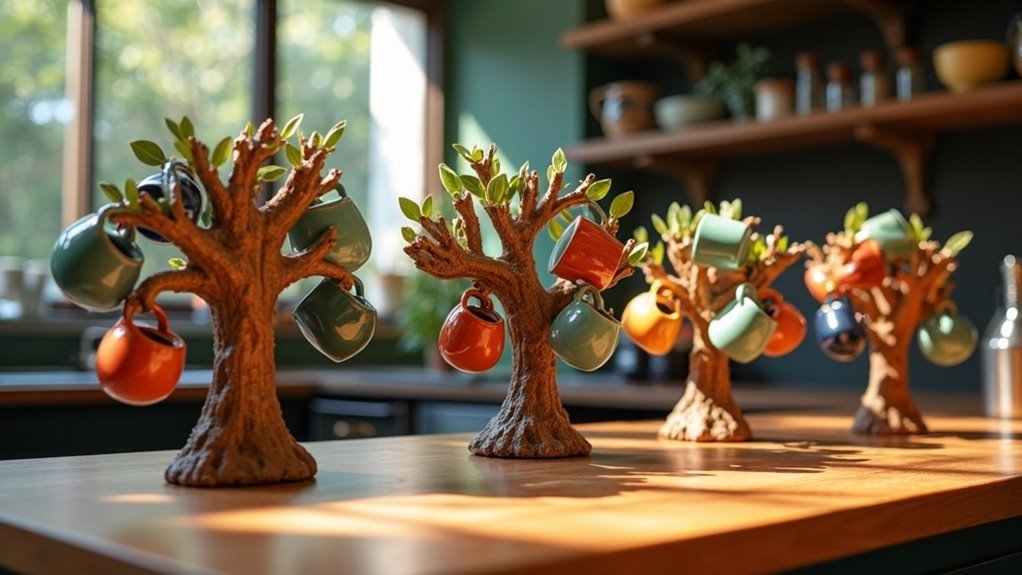Colombian coffee varietals primarily consist of Arabica beans, celebrated for their unique flavors that are influenced by the rich volcanic soils and high altitudes of the region. Notable varietals such as Typica and Bourbon deliver complex flavor profiles and varying yields, while Caturra and Castillo contribute brightness and disease resistance. Additionally, distinctive varieties like Tabi and Gesha present exceptional taste experiences. The processing methods used play a crucial role in enhancing these characteristics. By exploring these elements, you can gain a deeper appreciation for the intricacies of Colombian coffee.
Key Takeaways
- Colombian coffee is renowned for its primarily Arabica beans, celebrated for their unique and diverse flavor profiles.
- Notable varietals include Typica, Bourbon, Caturra, Castillo, Tabi, and Gesha, each contributing distinct characteristics to the coffee experience.
- Typica is known for its bold flavors and lower yields, while Bourbon offers a richer taste and higher yields.
- Caturra and Castillo are favored for their bright acidity and disease resistance, thriving in Colombia’s nutrient-rich volcanic soils.
- Various processing methods, such as dry and wet processing, enhance the coffee’s flavor clarity and complexity, making Colombian coffee a favorite among enthusiasts.
Overview of Colombian Coffee Varietals
Colombian coffee varietals represent a diverse and fascinating aspect of the coffee industry, primarily featuring Arabica beans that stand out for their unique flavors and characteristics.
Among these, Typica is celebrated for its balanced flavors with floral and citrus notes, making it a favorite among coffee enthusiasts. Bourbon offers a rich profile that many appreciate, although it’s susceptible to disease, which can pose challenges for growers.
Typica captivates with its floral and citrus notes, while Bourbon delights with richness, despite its disease susceptibility.
Caturra, a dwarf mutation of Bourbon, is noteworthy for its higher yields and bright acidity, making it an appealing choice for producers looking to maximize output. Castillo, designed specifically for disease resistance, has become the most widely cultivated varietal due to its remarkable adaptability to various growing conditions.
Lastly, Variedad Colombia enhances sustainability within the industry; as a hybrid that effectively combats Coffee Leaf Rust, it plays a crucial role in bolstering the resilience of Colombian coffee against environmental pressures.
Key Varietals: Typica and Bourbon
When exploring the rich landscape of Colombian coffee, two varietals stand out: Typica and Bourbon.
Typica is celebrated for its bold, complex flavors and elongated cherries, though its lower yield makes it less common in cultivation.
Conversely, Bourbon, named after a French region, boasts a 20-30% higher yield and features small, dense cherries.
Both varietals thrive at high altitudes, enhancing their flavor profiles and contributing to the distinct taste characteristics of Colombian coffee.
Despite Typica’s vulnerability to diseases, the combination of yield and richness in flavor makes Bourbon a preferred choice among coffee producers, ensuring the quality and diversity of Colombian coffee remains exceptional.
Exploring Caturra and Castillo
Caturra and Castillo represent two significant advancements in Colombian coffee cultivation, each offering unique attributes that cater to diverse preferences among coffee enthusiasts.
Caturra, a dwarf mutation of Bourbon, is cherished for its clean, sweet cup and bright acidity. Meanwhile, Castillo, developed through extensive hybridization, boasts resistance to Coffee Leaf Rust and higher yields, making it the most cultivated variety.
Both thrive in Colombia’s rich volcanic soils, enhancing their unique flavor profiles shaped by diverse microclimates. Caturra often reveals delightful citrus and caramel notes, while Castillo offers a broad spectrum of flavors ranging from fruity to chocolatey, appealing to both specialty coffee lovers and producers alike.
Unique Varieties: Tabi and Gesha
While exploring the unique coffee varietals of Tabi and Gesha, you’ll discover that both exemplify the rich diversity and innovation within Colombia’s coffee landscape.
- Tabi: This hybrid coffee varietal is notable for its resilience against Coffee Leaf Rust, making it a robust choice for growers.
- Gesha: Celebrated for its floral, tea-like notes and delicate acidity, Gesha stands out in the coffee community.
- Tabi trees: These trees are characterized by their tall trunks and long branches, which enhance cultivation efficiency.
- Gesha’s genetic profile: Its distinct genetic background elevates Gesha as a favorite among coffee connoisseurs.
Together, these varietals highlight how hybridization and unique flavor profiles advance Colombian coffee, ensuring high-quality offerings while emphasizing resilience and sustainability in farming practices.
The Impact of Terroir on Flavor Profiles
Understanding how terroir influences flavor profiles is essential for appreciating the nuances of Colombian coffee.
In the Coffee Triangle, factors like volcanic soil and altitude create ideal conditions for diverse coffee varietals. Higher elevations, ranging from 800 to 2,000 meters, enhance brightness and acidity, while varying climatic conditions across regions yield distinct flavor characteristics.
For instance, Caturra from Huila often showcases a clean sweetness, while Castillo from Antioquia offers rich, deep flavors.
The interplay between these environmental elements and the specific coffee varietals cultivated shapes the remarkable complexity and richness of Colombian coffee, making each cup a unique sensory experience.
Processing Methods of Colombian Coffee
When exploring the processing methods of Colombian coffee, you’ll discover that both wet and dry techniques are crucial in shaping its unique flavor profile.
The traditional washed method enhances clarity and brightness by fermenting and washing the beans, while natural processing retains the fruit, resulting in a bolder, fruitier taste.
Understanding these methods enriches your appreciation of how they influence the distinct characteristics of Colombian coffee.
Dry Processing Techniques
In the world of coffee processing, dry processing techniques stand out for their unique ability to enhance the natural flavors of the beans. This method, also known as natural processing, involves drying whole coffee cherries in the sun, intensifying fruity notes in the final cup.
- Rich berry-like flavors
- Heavier body and complexity
- Varietals such as Caturra and Castillo
- Less water-intensive, making it ideal for water-scarce regions
The choice of dry processing greatly impacts the flavor profile and quality of Colombian coffee, underscoring the crucial role of farmer expertise in selecting the appropriate processing methods.
Wet Processing Methods
While dry processing brings out the fruity notes in coffee, wet processing methods play an essential role in defining the clarity and brightness of Colombian coffee.
This technique involves de-pulping coffee cherries, followed by fermentation lasting 12 to 36 hours, which removes mucilage and enhances the unique characteristics of varietals like Caturra and Castillo.
After washing, beans are dried to 10-12% moisture for ideal preservation.
The result is a cleaner flavor profile that highlights the coffee’s acidity and brightness, contributing to the high quality often recognized by the Specialty Coffee Association, with many coffees scoring 80 points or above.
Challenges and Innovations in Colombian Coffee Production
As climate change increasingly disrupts Colombian coffee production, farmers face a dual challenge of maintaining crop quality while managing rising costs.
- Altered weather patterns threaten coffee yields.
- Coffee borer beetles invade more frequently, impacting bean quality.
- Innovations in breeding programs yield disease-resistant varietals like Castillo, enhancing resilience.
- The Colombian Coffee Federation actively promotes sustainable practices to support farmers.
Smallholder farmers, who are often the backbone of Colombian specialty coffees, struggle with labor shortages and inflation pressures.
Meanwhile, initiatives that recognize and empower women’s contributions in coffee cultivation are vital for community development.








